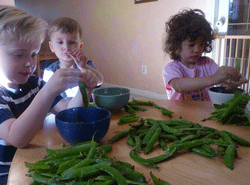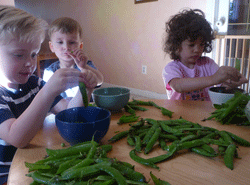 Getting children to try new foods can be a daunting task. Each child has his own palate which can be wildly different from siblings’ and other children’s in a similar age group. Every child will try new foods at their own pace, but there are various ways in which to expedite the process. Pairing new foods with familiar foods, considering portion size, and positive reinforcement when new foods are eaten by the child all help the child to try new things.
Getting children to try new foods can be a daunting task. Each child has his own palate which can be wildly different from siblings’ and other children’s in a similar age group. Every child will try new foods at their own pace, but there are various ways in which to expedite the process. Pairing new foods with familiar foods, considering portion size, and positive reinforcement when new foods are eaten by the child all help the child to try new things.
Many children who are born and grow in a consumer economy are exposed to various images and advertisements in their daily lives, many of which consist of food or food products. This creates an image of what a meal should be, and when combined with the few foods they know that they enjoy eating, a very closed-minded attitude towards new foods can ensue. Young children are often quite particular about what they eat, and new colors, shapes and smells appearing on a child’s plate can be very distressing, especially if the foods that they are used to seeing on that plate are nowhere to be found. Pairing new foods with foods children already know and enjoy is an easy way to expand the child’s diet without upsetting the flow of the meal. There are children at LifeWays who are very timid about new foods. On soup day, I serve a soup along with the fresh bread the children have baked with their caregivers in the morning, and for the children bread is a familiar and tasty food to eat. Some are reticent to eat the soup and will often ask for more bread after their first serving, to which the common response is, “Try your soup and you may have a little more bread.” Sampling a little bit of soup is a small task for more delicious bread, and often elicits a positive response from the child. This may only lead to a small taste the first time, but can bring about a half-eaten bowl before a request for more bread during the next soup meal.
Providing larger portions of familiar food alongside smaller portions of new food also helps children become more accepting of new foods. The children who are unsure about a new soup are often given a smaller portion alongside the bread that they enjoy. When they are asked to try their soup, they are not faced with a heaping bowl of soup in front of them, and this makes the task seem less daunting. As children become more brave and adventurous with their eating, they receive larger portions.
It is also important to give positive reinforcement to keep children trudging forward in their palate-expanding odyssey. Without being too attached to children eating all the food on their plate or creating an emotionally charged stand-off, simply and matter-of-factly stating how happy you are that they are trying new foods goes a long way in promoting their sense of adventure. Children take pride in trying new things, especially if they like the new thing they’ve tried. I have heard calls of, “I tried the soup, can I have more bread?” grow into, “I ate all my soup! It was really good!” Fostering their joy of experiencing unknown flavors will add to their sense of adventure when it comes to eating.
New foods can be fun and exciting but frightening and distressing at the same time. It is important to bring new foods into a child’s meal in ways that keep them tethered to the diet they know and prefer. In this way they will move forward into a full and balanced diet at their own pace.
Jeremy Bucher is a caregiver at LifeWays of Milwaukee and wrote this article for their winter newsletter.
